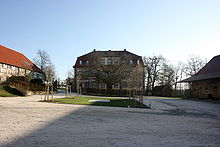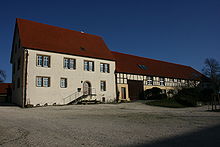Ludwigsruhe
Ludwigsruhe is an estate in Hohenlohe and a district of the city of Langenburg in the Schwäbisch Hall district in Baden-Württemberg . Until August 11, 1761, the place was called Lindenbronn, after which it was renamed after the builder of the pleasure palace , Ludwig, Graf zu Hohenlohe-Langenburg .
history
The area of the hamlet of Lindenbronn, which was sold in the 14th century, came to the Hohenlohe- Langenburg house in 1556 . In the following years they had a 28 hectare hunting park laid out, which was also surrounded by a wall in 1750.
From 1736 Count Ludwig zu Hohenlohe-Langenburg had a summer residence built directly at the hunting park based on plans by Leopoldo Retti . Retti's original design was based on the forms of Parisian urban architecture at the beginning of the 18th century and was only implemented in a simplified manner. The result was a two-story, plastered hunting lodge with a little protruding central projectile and a mansard hipped roof . Inside the castle is equipped with a few utility rooms, a garden and dining room on the ground floor, a larger hall on the upper floor and three residential apartments. This corresponds entirely to the type of maison de plaisance, which was also invented in France . In Ludwigsruhe, elements of the Ansbach court architecture, Ludwigsburg frame structures and drilled window frames that cannot be explained in terms of origin are mixed in the facades . Construction was completed in 1743 and the entire place was renamed Ludwigsruhe after the builder. During or shortly after the completion of the palace, a star-shaped network of paths was laid out in the park, which leads to a monument to the deceased Prince Christian Albrecht von Hohenlohe-Langenburg , the son of Ludwig. In the 19th century a Swiss factory (= dairy) belonged to the estate.
Gut and Schloss Ludwigsruhe have been privately owned since 1980 and can be rented for events.
Natural monuments
- Oak on the edge of the castle park with a chest height of 7.25 m (2014).
literature
- Ludwigsruhe Castle. In: Walther-Gerd Fleck: Castles and palaces in Northern Württemberg. Weidlich, Frankfurt am Main 1979, ISBN 3-8035-1014-7 , pp. 275-278.
- Klaus Merten: The castles of the counts and princes of Hohenlohe in the 18th century . In: Harald Siebenmorgen (Ed.): Hofkunst in Hohenlohe , Sigmaringen 1996, pp. 23–38.
- Gerhard Taddey : Court art in Hohenlohe - the historical environment . In: Harald Siebenmorgen (Ed.): Hofkunst in Hohenlohe , Sigmaringen 1996, pp. 19–22.
- Rolf Bidlingmaier: The brothers Riccardo, Paolo, Livio and Leopoldo Retti. A Northern Italian family of artists in the Duchy of Württemberg . In: Association for family and heraldry in Württemberg and Baden (Hrsg.): Südwestdeutsche Blätter for family and heraldry . tape 21 , no. 13 , 1997, ISSN 0172-1844 , pp. 569-584 .
Web links
Coordinates: 49 ° 15 ′ 42 " N , 9 ° 53 ′ 34" E
Individual evidence
- ↑ Max Miller , Gerhard Taddey (ed.): Handbook of the historical sites of Germany . Volume 6: Baden-Württemberg (= Kröner's pocket edition . Volume 276). 2nd, improved and enlarged edition. Kröner, Stuttgart 1980, ISBN 3-520-27602-X , p. 449.
- ↑ a b Dagmar Zimdars (arrangement): Georg Dehio: Handbook of German Art Monuments. Baden-Württemberg I. Deutscher Kunstverlag, Berlin and Munich, 1993, ISBN 3-422-03024-7 , p. 487f.
- ↑ leopoldo-retty.de: buildings outside the stately building industry .
- ↑ Description of the Oberamt Gerabronn. Published by the Royal Statistical-Topographical Bureau, Cotta, Stuttgart and Tübingen, 1847, p. 300.
- ^ F. Ludwig: Newest Conversations Lexicon; or, general German real encyclopedia for educated states , Vienna 1830.
- ^ Landesarchiv Baden-Württemberg (Ed.): The district of Schwäbisch Hall. Volume 2. Thorbecke, Ostfildern, 2005, ISBN 3-7995-1366-3 , p. 69.
- ^ Entry in the directory of monumental oaks . Retrieved January 10, 2017

